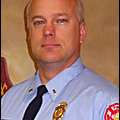Hazardous materials response is, and always has been, a logical extension of a fire department's mission of saving lives and property. Similarly, many skills learned as a firefighter cross over well when it comes to hazmat response tactics and tasks. One such skill is that of making a water chute with pike poles and a tarp. These water chutes also serve to divert chemical leaks when deployed at hazmat incidents.
Hazmat chutes can be easily deployed for a multitude of chemical incidents. Inside spills can be diverted away from drains or other unwanted areas with a chute. Outside spills can be diverted to collection basins or to areas where the spill can be more easily handled with a chute. Another use is to divert leaks from under rail cars or highway bulk containers or even smaller non-bulk containers. Chutes are especially helpful when the leaking material may react with the surface below the container or any other material that it may contact.
Here are some considerations when deploying a chute for leak control under a container:
While approaching the leak area from upwind, maintain situational awareness by observing your surroundings. Look for trip hazards, product pools and other obstacles. When dealing with vehicles, chock the wheels to avoid vehicle movement. Ensure that the highway has been shut down or the railroad has been contacted to stop train traffic.
Also, approach the spill area with appropriate monitoring instruments to screen for flammable, toxic, corrosive and even radioactive environments. Entry with the chute already constructed saves time in the "hot zone" or the chute can be constructed after seeing what is needed on location.
- If the chute is to be constructed near the leak area, lay the tarp out and roll it appropriately with the pike poles in unison. Ensure that the tarp is tight between the pike poles to better enable liquids to drain. Inexpensive repellent chutes work well as they will most likely be disposed after the incident.
- When the construction is complete, turn the chute over so the weight of the leaking material better secures it with the pike poles.
- Secure the pike pole ends so that the chute drains to a collection basin. Entry personnel should avoid kneeling in product whenever possible.
- Safety is paramount! Maintain situational awareness, check your air-monitoring results frequently, pay attention to time and air consumption, and provide periodic updates to hazmat control officers in the "cold zone".
Much of hazmat response is applying skills sets that are already possessed and the only limitations are your imagination and your pocketbook. It boils down to the application of problem-solving skills. Use all of this with the public's best interest in mind.
DAVID F. PETERSON is a lieutenant in the Madison, WI, Fire Department, where he is the lead fire and hazmat training officer. He is in his 30th year as an emergency responder and is the managing member for the Wisconsin FLAME Group LLC. Peterson also operates www.hazmatpetie.com, a hazardous materials response training website. Please send your comments and questions to him at www.hazmatpetie.com or [email protected].
About the Author

David F. Peterson
David F. Peterson, MS, EFO, is a 35-year veteran of the fire service and a retired Wisconsin fire chief. He is currently a fire training coordinator for Blackhawk Technical College in Janesville, WI. Peterson has served as a company officer, training officer, hazmat team leader, chief officer and incident commander. He is a past board member for the Wisconsin State Fire Chiefs Association, a national presenter on fire service and hazmat topics, and he founded the Wisconsin Association of Hazardous Materials Responders in 1992. Peterson has a master’s degree in executive fire leadership and disaster preparedness from Grand Canyon University and a bachelor’s degree in fire service management from the University of Southern Illinois. He is also a graduate of the National Fire Academy’s Executive Fire Officer Program. He is a principal partner of White Helmet Innovations, LLC.